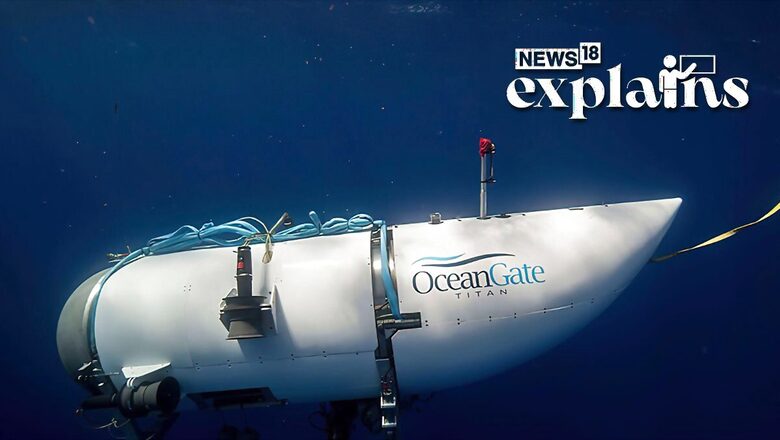
views
The US Navy’s acoustic system has detected an “anomaly” that is believed to be the cause of the fatal implosion of the Titan submersible, Associated Press quoted a senior military as saying. As per the report, the Navy analysed its acoustic data after the submersible was reported missing, and the Coast Guard later confirmed that the craft experienced a catastrophic implosion resulting in the death of all five individuals on board.
The anomaly detected by the Navy’s acoustic system was consistent with an implosion or explosion in the vicinity where the Titan submersible was operating when communication was lost. The senior Navy official, who spoke to Associated Press anonymously due to the sensitivity of the acoustic detection system, provided this information to the Coast Guard, which continued its search.
What is a Catastrophic Implosion and How is it Different from an Explosion?
Earlier, experts had expressed doubts about the implosion of the deepwater exploratory vessel, as no significant underwater sound wave had been registered to indicate such an event. However, it has now been confirmed that the missing craft succumbed to the immense pressures at the depth where the famous shipwreck lies on the floor of the Atlantic Ocean. The exact depth at which the “catastrophic implosion” occurred is still being determined.
When pressure inside a confined space becomes too great, it exerts outward force and can cause an explosion. An analogy can be drawn to blowing up a balloon excessively, where the material eventually reaches its limit and bursts, according to a report by AS.
Here is an example of a controlled implosion by a transportation company WABASH:
Here’s an example of what the implosion of the Titan submersible would have looked like. Potentially even more violent given the depths of the mission. #Titan #Titanic #OceanGate #implosion #submarine #submarinemissing pic.twitter.com/1hZTjlxOMg— Messias (@honestfan_1) June 23, 2023
Conversely, when a container experiences more pressure from the outside than it can withstand, it collapses inward, resulting in an implosion. This effect can be demonstrated in a classroom experiment often performed by science teachers. It involves heating an empty soda can and then submerging it, with the opening facing into a freezing liquid. The can crumples inward as if it were crushed, the report explains.
Concerns Existed About Oceangate Before
The incident has sparked discussions about the safety of deep-sea tourism, particularly focusing on OceanGate, the company involved, according to CNN.
Former employees of OceanGate have raised concerns about the thickness of the Titan’s hull, suggesting potential safety issues.
Furthermore, conflicting information has emerged regarding the engineering and testing of the vessel, with a research lab’s statement indicating discrepancies.
Despite OceanGate’s legal representative claiming the Titan’s exceptional safety features, the University of Washington’s Applied Physics Laboratory, allegedly involved in its development, denied any association with the design, engineering, or testing of the submersible.
Industry leaders also expressed concerns about OceanGate’s “experimental approach” to the Titan submersible and its Titanic expedition, as highlighted in a letter sent to the missing CEO, Stockton Rush, by the Manned Underwater Vehicles committee of the Marine Technology Society in 2018. The letter warned of potential negative outcomes with serious consequences for the industry.
Passengers who were about to board OceanGate’s submarines for the expedition to the Titanic wreckage were presented with a contract warning them about the potential risks involved. The contract stated that the expedition had not been approved or certified by any regulatory body and that it carried the possibility of physical injury, disability, motion trauma, or even death, according to a report by The Independent.
There have been several warning signs about potential issues with OceanGate’s Titan submarine. A former employee, David Lochridge, filed a lawsuit alleging that he was fired for raising concerns about safety issues with the ship.
These concerns included flaws in the hull, flammable materials onboard, an inadequate viewing window, and missing safety documents. Lochridge pushed for further testing and third-party evaluation but was terminated when he refused to authorize manned testing without hull scans.
In addition, an industry letter in 2018 expressed unanimous concern about the company’s decision not to seek external evaluation and testing, emphasizing the importance of safeguards in submersibles.
WHAT’S NEXT AND WHO WAS KILLED?
The Coast Guard will continue searching near the Titanic for more clues about what happened to the Titan.
Efforts to recover the submersible and the remains of the five men who were on board will also continue.
The victims are: Oceangate chief executive and Titan pilot Stockton Rush; two members of a prominent Pakistani family, Shahzada Dawood and his son Suleman Dawood; British adventurer Hamish Harding; and Titanic expert Paul-Henri Nargeolet.
“These men were true explorers who shared a distinct spirit of adventure, and a deep passion for exploring and protecting the world’s oceans,” OceanGate said in a statement. “We grieve the loss of life and joy they brought to everyone they knew.”
Associated Press contributed to this report




















Comments
0 comment